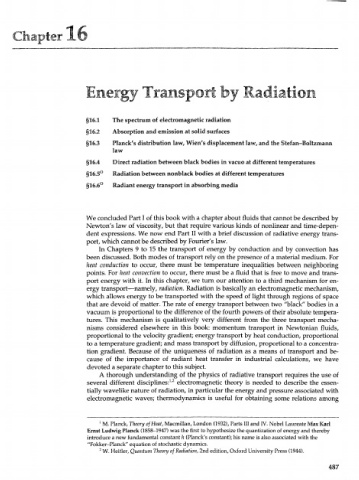Page 507 - Bird R.B. Transport phenomena
P. 507
§16.1 The spectrum of electromagnetic radiation
§16.2 Absorption and emission at solid surfaces
§16.3 Planck's distribution law, Wien's displacement law, and the Stefan-Boltzmann
law
§16.4 Direct radiation between black bodies in vacuo at different temperatures
§16.5° Radiation between nonblack bodies at different temperatures
§16.6° Radiant energy transport in absorbing media
We concluded Part I of this book with a chapter about fluids that cannot be described by
Newton's law of viscosity, but that require various kinds of nonlinear and time-depen-
dent expressions. We now end Part II with a brief discussion of radiative energy trans-
port, which cannot be described by Fourier's law.
In Chapters 9 to 15 the transport of energy by conduction and by convection has
been discussed. Both modes of transport rely on the presence of a material medium. For
heat conduction to occur, there must be temperature inequalities between neighboring
points. For heat convection to occur, there must be a fluid that is free to move and trans-
port energy with it. In this chapter, we turn our attention to a third mechanism for en-
ergy transport—namely, radiation. Radiation is basically an electromagnetic mechanism,
which allows energy to be transported with the speed of light through regions of space
that are devoid of matter. The rate of energy transport between two "black" bodies in a
vacuum is proportional to the difference of the fourth powers of their absolute tempera-
tures. This mechanism is qualitatively very different from the three transport mecha-
nisms considered elsewhere in this book: momentum transport in Newtonian fluids,
proportional to the velocity gradient; energy transport by heat conduction, proportional
to a temperature gradient; and mass transport by diffusion, proportional to a concentra-
tion gradient. Because of the uniqueness of radiation as a means of transport and be-
cause of the importance of radiant heat transfer in industrial calculations, we have
devoted a separate chapter to this subject.
A thorough understanding of the physics of radiative transport requires the use of
1 2
several different disciplines: ' electromagnetic theory is needed to describe the essen-
tially wavelike nature of radiation, in particular the energy and pressure associated with
electromagnetic waves; thermodynamics is useful for obtaining some relations among
1
M. Planck, Theory of Heat, Macmillan, London (1932), Parts III and IV. Nobel Laureate Max Karl
Ernst Ludwig Planck (1858-1947) was the first to hypothesize the quantization of energy and thereby
introduce a new fundamental constant h (Planck's constant); his name is also associated with the
"Fokker-Planck" equation of stochastic dynamics.
2
W. Heitler, Quantum Theory of Radiation, 2nd edition, Oxford University Press (1944).
487

